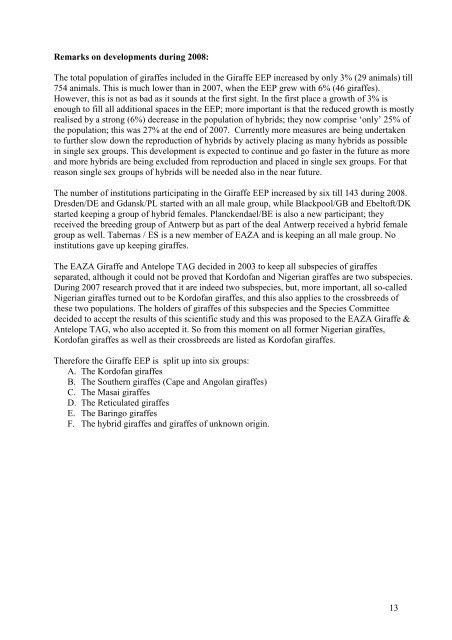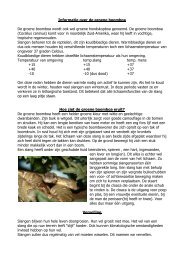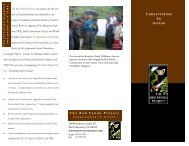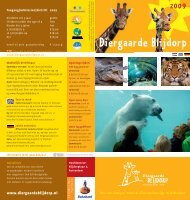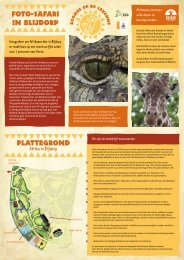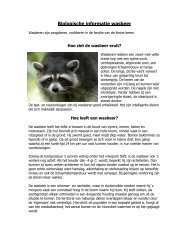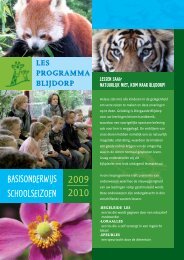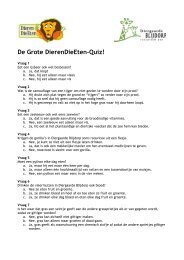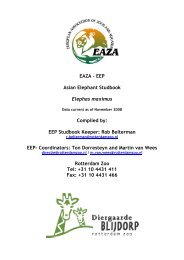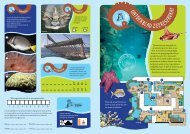European studbook for the giraffe eep
European studbook for the giraffe eep
European studbook for the giraffe eep
You also want an ePaper? Increase the reach of your titles
YUMPU automatically turns print PDFs into web optimized ePapers that Google loves.
Remarks on developments during 2008:<br />
The total population of <strong>giraffe</strong>s included in <strong>the</strong> Giraffe EEP increased by only 3% (29 animals) till<br />
754 animals. This is much lower than in 2007, when <strong>the</strong> EEP grew with 6% (46 <strong>giraffe</strong>s).<br />
However, this is not as bad as it sounds at <strong>the</strong> first sight. In <strong>the</strong> first place a growth of 3% is<br />
enough to fill all additional spaces in <strong>the</strong> EEP; more important is that <strong>the</strong> reduced growth is mostly<br />
realised by a strong (6%) decrease in <strong>the</strong> population of hybrids; <strong>the</strong>y now comprise ‘only’ 25% of<br />
<strong>the</strong> population; this was 27% at <strong>the</strong> end of 2007. Currently more measures are being undertaken<br />
to fur<strong>the</strong>r slow down <strong>the</strong> reproduction of hybrids by actively placing as many hybrids as possible<br />
in single sex groups. This development is expected to continue and go faster in <strong>the</strong> future as more<br />
and more hybrids are being excluded from reproduction and placed in single sex groups. For that<br />
reason single sex groups of hybrids will be needed also in <strong>the</strong> near future.<br />
The number of institutions participating in <strong>the</strong> Giraffe EEP increased by six till 143 during 2008.<br />
Dresden/DE and Gdansk/PL started with an all male group, while Blackpool/GB and Ebeltoft/DK<br />
started k<strong>eep</strong>ing a group of hybrid females. Planckendael/BE is also a new participant; <strong>the</strong>y<br />
received <strong>the</strong> breeding group of Antwerp but as part of <strong>the</strong> deal Antwerp received a hybrid female<br />
group as well. Tabernas / ES is a new member of EAZA and is k<strong>eep</strong>ing an all male group. No<br />
institutions gave up k<strong>eep</strong>ing <strong>giraffe</strong>s.<br />
The EAZA Giraffe and Antelope TAG decided in 2003 to k<strong>eep</strong> all subspecies of <strong>giraffe</strong>s<br />
separated, although it could not be proved that Kordofan and Nigerian <strong>giraffe</strong>s are two subspecies.<br />
During 2007 research proved that it are indeed two subspecies, but, more important, all so-called<br />
Nigerian <strong>giraffe</strong>s turned out to be Kordofan <strong>giraffe</strong>s, and this also applies to <strong>the</strong> crossbreeds of<br />
<strong>the</strong>se two populations. The holders of <strong>giraffe</strong>s of this subspecies and <strong>the</strong> Species Committee<br />
decided to accept <strong>the</strong> results of this scientific study and this was proposed to <strong>the</strong> EAZA Giraffe &<br />
Antelope TAG, who also accepted it. So from this moment on all <strong>for</strong>mer Nigerian <strong>giraffe</strong>s,<br />
Kordofan <strong>giraffe</strong>s as well as <strong>the</strong>ir crossbreeds are listed as Kordofan <strong>giraffe</strong>s.<br />
There<strong>for</strong>e <strong>the</strong> Giraffe EEP is split up into six groups:<br />
A. The Kordofan <strong>giraffe</strong>s<br />
B. The Sou<strong>the</strong>rn <strong>giraffe</strong>s (Cape and Angolan <strong>giraffe</strong>s)<br />
C. The Masai <strong>giraffe</strong>s<br />
D. The Reticulated <strong>giraffe</strong>s<br />
E. The Baringo <strong>giraffe</strong>s<br />
F. The hybrid <strong>giraffe</strong>s and <strong>giraffe</strong>s of unknown origin.<br />
13


